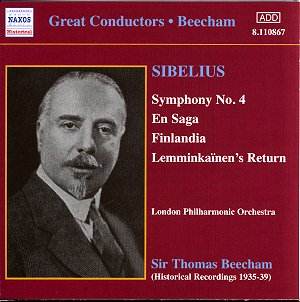As a sampler of Beecham's Sibelius from the 1930s
this takes some beating. The only significant lacuna is Beecham's
version of the Sixth Symphony (which you can hear on EMI Classics
CDM 7 64027 2 Beecham Edition if you can track it down) complete
with 78 swish in the first movement.
En Saga has the strange distinction
of having been recorded from sessions in two different halls not
that it is noticeable. This version does not boil like the molten
Furtwängler version (1943) taken down from a wartime concert
in Berlin nor does it have the blazing vigour of Horst Stein's
miraculously well recorded version on Decca. It is still well
worth your 'ear-time' complete with Beecham's caring interventions.
Notice, for example, the tender slowing at 10.03 and the 'catch
in the throat' in the proto-Tapiola gale at 13.12.
Lemminkainen's Return was one
of Beecham's party-pieces in which vertiginous velocity was all
part of the fun. Listen to the scudding adrenalin of the cellos
at 1.32. The musicians play with furies and flames at their heels:
breathtaking but not gabbled. Such a pity that it was not the
fashion in the 1930s to perform the complete Lemminkäinen
Suite. While we have the supreme 1979 Ormandy on EMI many
of us would give our eye teeth if we had them to hear Beecham
conducting Lemminkäinen and the Maidens of Saari. Strange
too how, in more recent years, that suite has also been shunned
by another eminent Sibelian: Paavo Berglund.
After such high jinks comes respite in the shape
of that regretful threnody and song of long gone castle evenings,
The Bard. This is a pastel miniature touched in
with gentle hues rather than garish smears of colour. This is
Sibelius at close his minimalist polarity.
Festivo has all the usual virtues
- unanimity, sturdy tone, Spanish local colour (2.39) .... and
castanets! His Finlandia is imbued with effortful
emphasis and deliberation.
I have compared Finlandia with
its EMI self on The Beecham Edition EMI Classics CDM 7 63397
2. The EMI sounds clearer, perhaps a shade glassy, and the surface
burble is more irregular than on the warmer Naxos.
The Fourth Symphony is the most substantial
item here. Kin to The Bard and Luonnotar (will someone
please reissue the Schneevoight recording of that piece?) this
is the most elusive of Sibelius's symphonies. It stands aside
from the romantic tumult and presents an aspect of the cold-eyed
remoteness of Holst's Betelgeuse, Egdon Heath and
parts of the Hymn of Jesus. Comparing the Naxos transfer
with its version on CDM 7 64027 2 the Naxos is at a disadvantage.
There is a liveliness, an impact, even a shrillness and pristine
focus that is not there to the same degree in the Naxos. This
is somewhat academic as Beecham Edition, EMI Classics CDM
7 64027 2 is long deleted but if you see it do buy it. Not only
does the Fourth sound better it is also coupled with the Sixth
Symphony and other shorter pieces.
Good documentation, fully detailed by Lyndon
Jenkins no less. Mark Obert-Thorn wields his usual benevolent
wand over the transfer process. In his note he points out that
he used pre-War US Victor Gold Label pressings except for Finlandia
which was from a Columbia 'Full range' label disc.
I should just point out that playing time is
about as generous as it could be.
An outstanding bargain in every respect. Go for
it. If you want modern sound in these works then opt for Ashkenazy
or Maazel on the Fourth and though hardly modern Horst Stein or
Barbirolli in Finlandia and En Saga.
Rob Barnett
